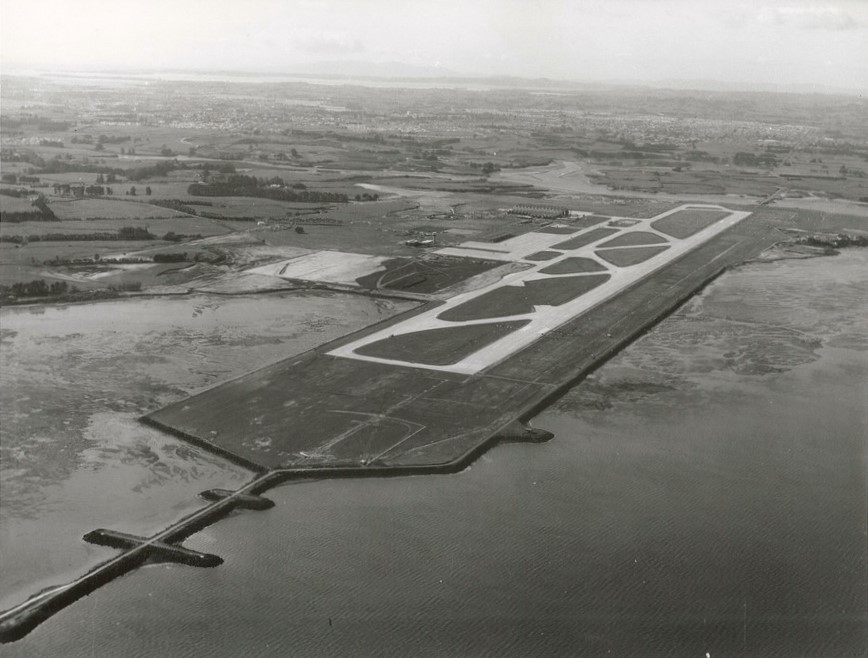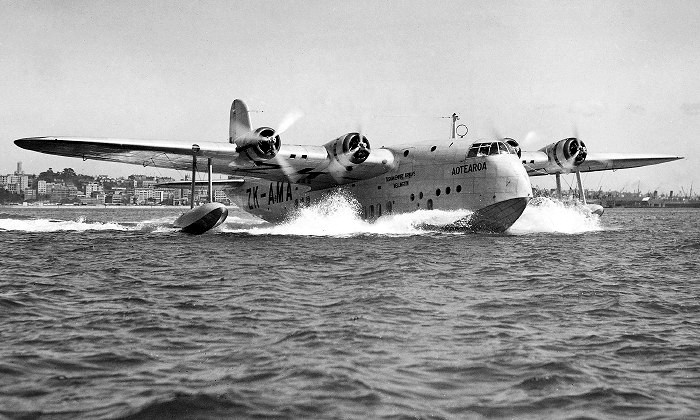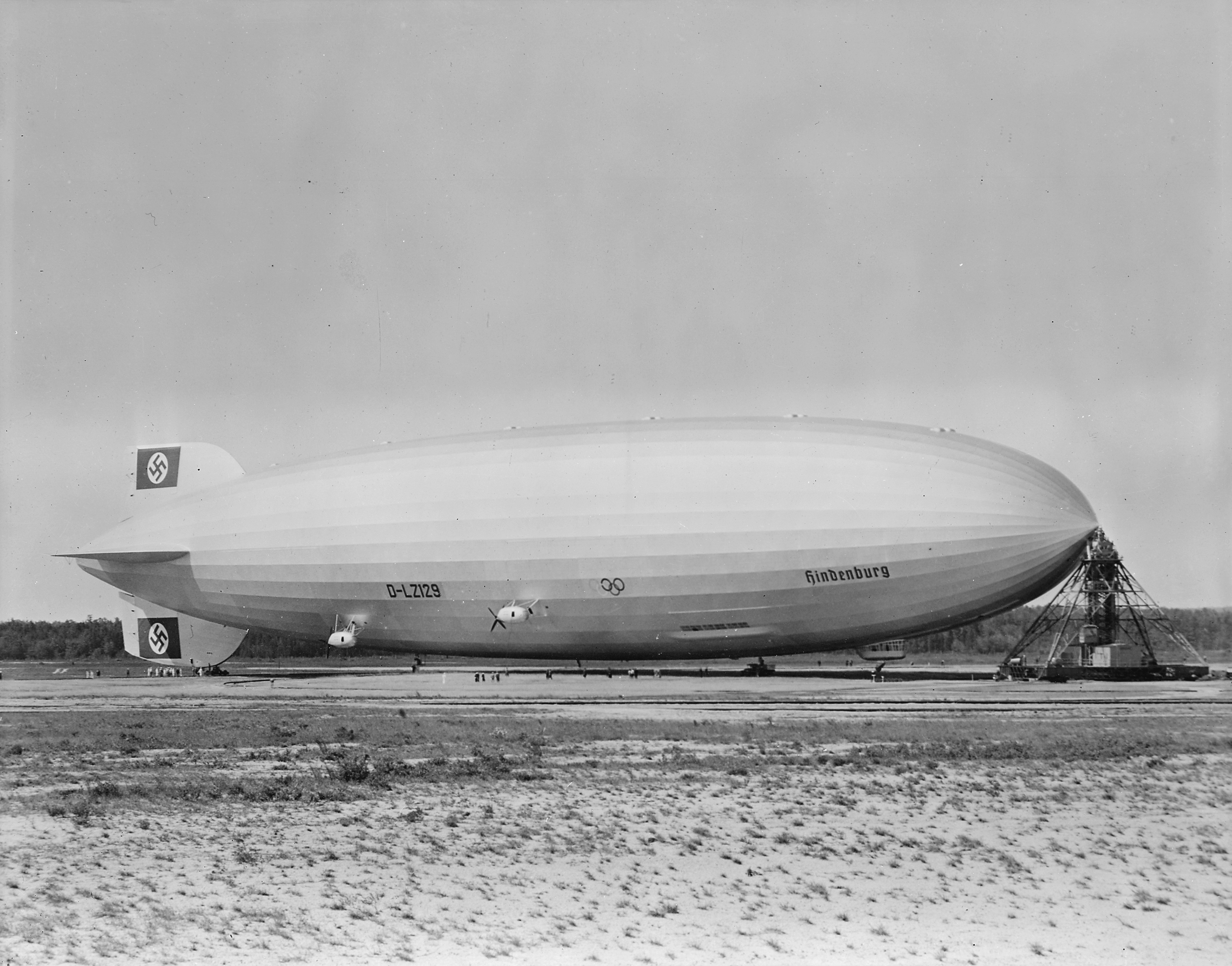|
1966 Air New Zealand DC-8 Crash
On 4 July 1966 an Air New Zealand Douglas DC-8-52 with the registration ZK-NZB crashed on takeoff on a routine training flight from Auckland International Airport killing 2 of the 5 crew on board. Aircraft The aircraft registered ZK-NZB was the second Douglas DC-8-52 delivered new to the airline in August 1965. It was one year old at the time of the crash. Accident The aircraft took off at 3:59pm. Shortly after rotation the aircraft began to pitch up faster and higher than usual, the right wing dropped and the aircraft started turning to the right. The aircraft failed to gain speed and altitude, the right wingtip struck the ground and cartwheeled while disintegrating, the initial impact occurred beyond the threshold and right of runway 23, the aeroplane was completely destroyed. Cause The crash was due to reverse thrust applied during a simulated failure of no.4 engine on takeoff. The situation occurred when very rapid rearward movement of the power lever caused the associa ... [...More Info...] [...Related Items...] OR: [Wikipedia] [Google] [Baidu] |
Engine Failure
A turbine engine failure occurs when a turbine engine unexpectedly stops producing power due to a malfunction other than fuel exhaustion. It often applies for aircraft, but other turbine engines can fail, like ground-based turbines used in power plants or combined diesel and gas vessels and vehicles. Reliability Turbine engines in use on today's turbine-powered aircraft are very reliable. Engines operate efficiently with regularly scheduled inspections and maintenance. These units can have lives ranging in the thousands of hours of operation. However, engine malfunctions or failures occasionally occur that require an engine to be shut down in flight. Since multi-engine airplanes are designed to fly with one engine inoperative and flight crews are trained to fly with one engine inoperative, the in-flight shutdown of an engine typically does not constitute a serious safety of flight issue. The Federal Aviation Administration (FAA) was quoted as stating turbine engines have a f ... [...More Info...] [...Related Items...] OR: [Wikipedia] [Google] [Baidu] |
Auckland International Airport
Auckland Airport is the largest and List of the busiest airports in New Zealand, busiest airport in New Zealand, with over 21 million passengers in the year ended March 2019. The airport is located near Māngere, a residential suburb, and Airport Oaks, a service hub suburb south of the Auckland Auckland CBD, city centre. It is both a domestic and international hub for Air New Zealand, and the New Zealand hub of Jetstar. The airport is one of New Zealand's most important infrastructure assets, providing thousands of jobs for the region. It handled 71 per cent of New Zealand's international air passenger arrivals and departures in 2000. It is one of only two commercial airports in New Zealand (the other being Christchurch International Airport, Christchurch) capable of handling Boeing 747 and Airbus A380 aircraft. The airport has a single runway, 05R/23L, which is Category III approach, Cat IIIb capable (at a reduced rate of movements) in the 23L direction. It has a capacity o ... [...More Info...] [...Related Items...] OR: [Wikipedia] [Google] [Baidu] |
Douglas DC-8-52
The Douglas DC-8 (sometimes McDonnell Douglas DC-8) is a long-range narrow-body airliner built by the American Douglas Aircraft Company. After losing the May 1954 US Air Force tanker competition to the Boeing KC-135, Douglas announced in July 1955 its derived jetliner project. In October 1955, Pan Am made the first order along with the competing Boeing 707, and many other airlines followed. The first DC-8 was rolled out in Long Beach Airport on April 9, 1958, and flew for the first time on May 30. FAA certification was achieved in August 1959 and the DC-8 entered service with Delta Air Lines on September 18. The six-abreast, low wing airliner was a four-engined jet aircraft with initial variants being long. The DC-8-10 was powered by Pratt & Whitney JT3C turbojets and had a MTOW, the DC-8-20 had more powerful JT4A turbojets for a MTOW. The intercontinental models had more fuel capacity and up to MTOW, powered by JT4As for the Series 30 and by Rolls-Royce Conway turbo ... [...More Info...] [...Related Items...] OR: [Wikipedia] [Google] [Baidu] |
Air New Zealand
Air New Zealand Limited () is the flag carrier airline of New Zealand. Based in Auckland, the airline operates scheduled passenger flights to 20 domestic and 30 international destinations in 18 countries, primarily around and within the Pacific Rim. The airline has been a member of the Star Alliance since 1999. Air New Zealand succeeded Tasman Empire Airways Limited on 1 April 1965. The airline served only international routes until 1978, when the government merged it and the domestic New Zealand National Airways Corporation (NAC) into a single airline under the Air New Zealand name. Air New Zealand was privatised in 1989, but returned to majority government ownership in 2001 after near bankruptcy due to a failed tie up with Australian carrier Ansett Australia. In the 2017 financial year to June, Air New Zealand carried 15.95 million passengers. Air New Zealand's route network focuses on Australasia and the South Pacific, with long-haul flight services to eastern Asia and Nor ... [...More Info...] [...Related Items...] OR: [Wikipedia] [Google] [Baidu] |
Air New Zealand Accidents And Incidents
The atmosphere of Earth is the layer of gases, known collectively as air, retained by Gravity of Earth, Earth's gravity that surrounds the planet and forms its planetary atmosphere. The atmosphere of Earth protects life on Earth by creating Atmospheric pressure, pressure allowing for Water#Liquid water, liquid water to exist on the Earth's Planetary surface, surface, absorbing ultraviolet Solar irradiance, solar radiation, warming the surface through heat retention (greenhouse effect), and reducing temperature extremes between Daytime, day and night (the diurnal temperature variation). By mole fraction (i.e., by number of molecules), dry air contains 78.08% nitrogen, 20.95% oxygen, 0.93% argon, 0.04% Carbon dioxide in Earth's atmosphere, carbon dioxide, and small amounts of other gases. Air also contains a variable amount of Water vapor#Water vapor in Earth's atmosphere, water vapor, on average around 1% at sea level, and 0.4% over the entire atmosphere. Air composition, tempera ... [...More Info...] [...Related Items...] OR: [Wikipedia] [Google] [Baidu] |
Aviation Accidents And Incidents In 1966
Aviation includes the activities surrounding mechanical flight and the aircraft industry. ''Aircraft'' includes fixed-wing and rotary-wing types, morphable wings, wing-less lifting bodies, as well as lighter-than-air craft such as hot air balloons and airships. Aviation began in the 18th century with the development of the hot air balloon, an apparatus capable of atmospheric displacement through buoyancy. Some of the most significant advancements in aviation technology came with the controlled gliding flying of Otto Lilienthal in 1896; then a large step in significance came with the construction of the first powered airplane by the Wright brothers in the early 1900s. Since that time, aviation has been technologically revolutionized by the introduction of the jet which permitted a major form of transport throughout the world. Etymology The word ''aviation'' was coined by the French writer and former naval officer Gabriel La Landelle in 1863. He derived the term from the v ... [...More Info...] [...Related Items...] OR: [Wikipedia] [Google] [Baidu] |
Accidents And Incidents Involving The Douglas DC-8
An accident is an unintended, normally unwanted event that was not directly caused by humans. The term ''accident'' implies that nobody should be blamed, but the event may have been caused by unrecognized or unaddressed risks. Most researchers who study unintentional injury avoid using the term ''accident'' and focus on factors that increase risk of severe injury and that reduce injury incidence and severity. For example, when a tree falls down during a wind storm, its fall may not have been caused by humans, but the tree's type, size, health, location, or improper maintenance may have contributed to the result. Most car wrecks are not true accidents; however English speakers started using that word in the mid-20th century as a result of media manipulation by the US automobile industry. Types Physical and non-physical Physical examples of accidents include unintended motor vehicle collisions, falls, being injured by touching something sharp or hot, or bumping into someth ... [...More Info...] [...Related Items...] OR: [Wikipedia] [Google] [Baidu] |
Aviation Accidents And Incidents In New Zealand
Aviation includes the activities surrounding mechanical flight and the aircraft industry. ''Aircraft'' includes fixed-wing and rotary-wing types, morphable wings, wing-less lifting bodies, as well as lighter-than-air craft such as hot air balloons and airships. Aviation began in the 18th century with the development of the hot air balloon, an apparatus capable of atmospheric displacement through buoyancy. Some of the most significant advancements in aviation technology came with the controlled gliding flying of Otto Lilienthal in 1896; then a large step in significance came with the construction of the first powered airplane by the Wright brothers in the early 1900s. Since that time, aviation has been technologically revolutionized by the introduction of the jet which permitted a major form of transport throughout the world. Etymology The word ''aviation'' was coined by the French writer and former naval officer Gabriel La Landelle in 1863. He derived the term from the v ... [...More Info...] [...Related Items...] OR: [Wikipedia] [Google] [Baidu] |
1966 Disasters In New Zealand
Events January * January 1 – In a coup, Colonel Jean-Bédel Bokassa takes over as military ruler of the Central African Republic, ousting President David Dacko. * January 3 – 1966 Upper Voltan coup d'état: President Maurice Yaméogo is deposed by a military coup in the Republic of Upper Volta (modern-day Burkina Faso). * January 10 ** Pakistani–Indian peace negotiations end successfully with the signing of the Tashkent Declaration, a day before the sudden death of Indian prime minister Lal Bahadur Shastri. ** Georgia House of Representatives, The House of Representatives of the US state of Georgia refuses to allow African-American representative Julian Bond to take his seat, because of his anti-war stance. ** A Commonwealth Prime Ministers' Conference convenes in Lagos, Nigeria, primarily to discuss Rhodesia. * January 12 – United States President Lyndon Johnson states that the United States should stay in South Vietnam until Communism, Communist aggression there is e ... [...More Info...] [...Related Items...] OR: [Wikipedia] [Google] [Baidu] |







